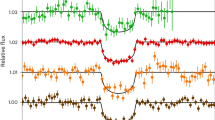Abstract
THE report1 of a possible detection of an X-ray emission line with energy about 53 keV from the binary X-ray source Her X-1 created great excitement. Interpreting the line as arising from non-relativistic electron cyclotron emission at the surface of an accreting neutron star member of the binary star system, Trumper et al.1 deduce a neutron star surface magnetic field of 4.6 × 1012 G. If the line is real (of cosmic origin and not due to background effects), significant (not due to a statistical fluctuation) and correctly interpreted as arising from non-relativistic cyclotron emission) it could provide the first direct and quantitative measure of the magnetic field of a neutron star, and be direct support for our ideas on the formation of neutron stars and the role of magnetic fields in the radiation mechanisms of pulsars and binary X-ray sources. Furthermore, it would conclusively rule out the possibility that Her X-1 contains a rotating or pulsating white dwarf (which, for dynamical stability requires B≪G1/2MR−2≃1012G for M≃M⊙ and R=RWD≃ 109 cm).
This is a preview of subscription content, access via your institution
Access options
Subscribe to this journal
Receive 51 print issues and online access
$199.00 per year
only $3.90 per issue
Buy this article
- Purchase on Springer Link
- Instant access to full article PDF
Prices may be subject to local taxes which are calculated during checkout
Similar content being viewed by others
References
Trumper, J., Pietsch, W., Reppin, C. & Sacco, B. Ann. N. Y. Acad. Sci. (in the press).
Coe, M. J., Engel, A. R., Quenby, J. J. & Dyer, C. S. Nature 268, 508 (1977).
Ulmer, M. P., Baity, W. A., Wheaton, W. A. & Peterson, L. E. Astrophys. J. Lett. 181, L33 (1973).
Ulmer, M. P., Baity, W. A., Wheaton, W. A. & Peterson, L. E. Astrophys. J. Lett. 178, L121 (1972).
Dyer, C. S. & Marfill, G. E. Astrophys. Space Sci. 14, 243 (1971).
Dyer, C. S., Engel, A. R. & Quenby, J. J. Astrophys. Space Sci. 19, 359 (1972).
Fishman, G. J. Astrophys. J. 171, 163 (1972).
Mackay, H. B., Ulmer, M. P. & Peterson, L. E. Astrophys. J. Suppl. (submitted).
Schwartz, D. A. & Peterson, L. E. Astrophys. J. 190, 297 (1974).
Ruderman, M. A. Rev. Astr. Astrophys. 10, 427 (1972).
Lodenquai, J., Canuto, V., Ruderman, M. & Tsuruta, S. Astrophys. J. 190, 141 (1974).
Gnedin, Y. N. & Sunyaev, Astr. Astrophys. 36, 379 (1974).
Illarionav, A. F. & Sunyaev, R. A. Astrophys. Space Sci. 19, 61 (1972).
Brecher, K. Astrophys. J. Lett. 215, L17 (1977).
Author information
Authors and Affiliations
Rights and permissions
About this article
Cite this article
BRECHER, K., ULMER, M. X-ray lines and magnetic field of Her X-1. Nature 271, 135–137 (1978). https://doi.org/10.1038/271135a0
Received:
Accepted:
Issue Date:
DOI: https://doi.org/10.1038/271135a0
This article is cited by
-
Spin alignment in a neutron star
Lettere al Nuovo Cimento (1980)
-
High energy X-ray spectrum of Her X-1
Nature (1978)
-
On the magnetic field of cosmological bodies
Lettere al Nuovo Cimento (1978)
Comments
By submitting a comment you agree to abide by our Terms and Community Guidelines. If you find something abusive or that does not comply with our terms or guidelines please flag it as inappropriate.



